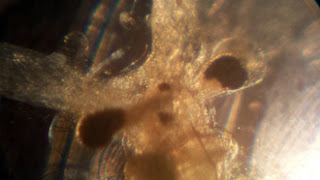Although I've already discussed the dangers of using biological control in various countries, a couple of recent events suggested I should write an update that concentrates on one particular example in New Zealand. I've mentioned elsewhere that my local reserve in Auckland is home to a large number of non-native species, from Australian eucalyptus trees and the associated (but accidentally imported) Emperor Gum moth, to California quail and Mexican gambusia fish. But having seen rainbow skink in my local environs, including a neighbour's garden, I was surprised to learn last week they are not native but yet another unplanned Australian import. Sure enough, the 1947 classic Powell's Native Animals of New Zealand makes no mention of the species in the page on the indigenous common skink and copper skink.
Earlier this year I read Quinn Berentson's superb Moa: the life and death of New Zealand's legendary bird, which lists fifty-eight avian species as having become extinct since humans first arrived in the country less than a thousand years ago. And of course this decimation of native fauna and flora may not yet have ended, with NIWA for example fighting a rear guard action against unwanted marine incomers such as polychaete worms arriving on ship's hulls and in discharged ballast water. Various sources suggest that well over one hundred introduced species of land animals, birds and fish are now widespread in New Zealand: what chance does the native ecosystem stand against this onslaught?
To add insult to injury, I recently read an OECD chart delineating business spend on research and development as a percentage of GDP, and was shocked to find that New Zealand was fourth from bottom of twenty-six nations, coming below western Europe, South Korea, Japan, Australia, Canada and the USA. Are our captains of industry really so short-sighted? As a country that depends extremely heavily on its dairy industry - an industry that is currently in dire straits - it seems sensible to invest a large amount of R&D in this sector. But alongside the eco-friendly solutions such as minimising methane emissions, there has been a new programme of biological control aimed at one particular side effect of dairy farming, namely the enormous amounts of cattle dung produced.
Across the Tasman, Australia has already been working on a similar scheme for the past half century, deliberately introducing numerous species of non-native dung beetles. New Zealand, home to over ten million cattle in a 3:2 dairy-to-meat ratio, obviously has issues with bovine manure management. Due to the lack of native ruminants the country's fifteen indigenous dung beetle species have evolved to mostly inhabit forests rather than grazing land.
There are various reasons why speeding up the rate of dung decomposition would improve farm land and the landscape in general, from preventing mineral imbalance in the soil and contamination of waterways to reduction in animal-infesting parasites such as nematode worms. But is it worth the risk to the greater environment, considering the dismal track record of biological control schemes around the world?
The new project is not the first time such insects have arrived in the country: in addition to three species accidentally imported from Australia and South Africa from the late Nineteenth Century onwards, the Mexican dung beetle (Copris incertus) was deliberately introduced into three areas in the 1950s but only thrived in the warm Northland climate. It is the scale of the new research that has set it apart: following caged field trials, the past two years has seen the widespread introduction of eleven non-native species across seven regions on both North and South Islands.
Bodies such as the Institute of Environmental Science and Research (ESR) have investigated the potential dangers to human health and the local ecology, even testing if possums, carriers of bovine tuberculosis, might see the exotic insects as a new food source. Even so, some professional scientists have deemed it a biosecurity disaster and one can see their point: using data from other countries' programmes is hardly a fool-proof comparison, considering the profoundly different indigenous ecosystems of Australia and New Zealand.
As a child I heard about the food chain or pyramid, but this is something of a misnomer. Just as natural selection works with bushes rather than linear progression, so there are food webs consisting of a complex series of trophic interactions. Although exotic dung beetles are unlikely to displace their native counterparts due to lack of shared environments, it is possible that other native species of grassland-living insects could suffer, such as humble earthworms. The problem is that without testing in various regions over long periods of time, it isn't viable to rule out such side consequences. Yet it isn't possible to undertake such tests without release into the wild: do we have something of a catch-22?
Having said that, there are no obvious signs that Australia's long-established dung beetle programme has had anything like the deleterious effects of its other biological control schemes, such as the cane toad fiasco. But then fifty years is a very short time in ecological timeframes and what to the casual glance of a farmer appears to be equilibrium could be apocalyptic at dung beetle scale. I wish the project good luck, but cannot help feeling that having received far more than its fair share of obnoxious aliens, New Zealand is the last place that needs yet more exotic species introduced onto its green and pleasant land.






